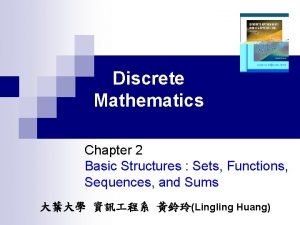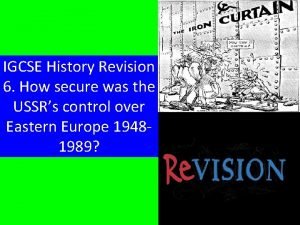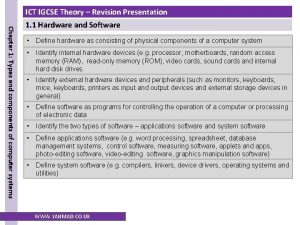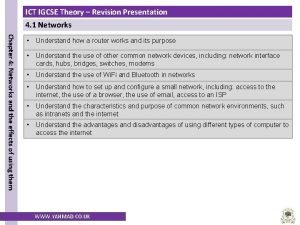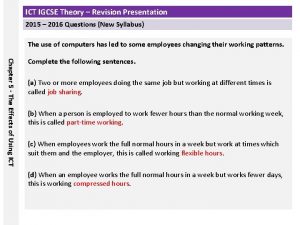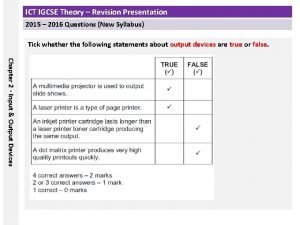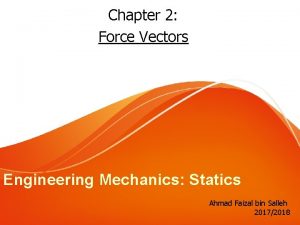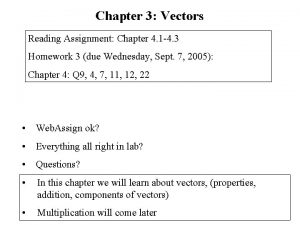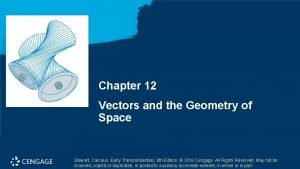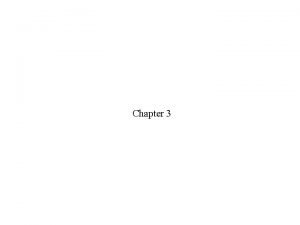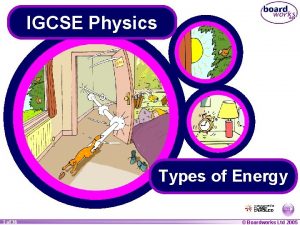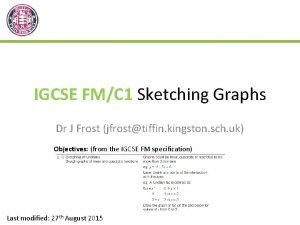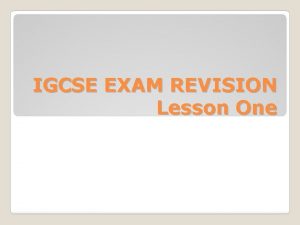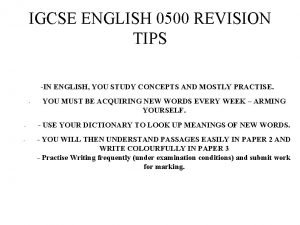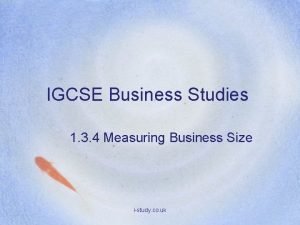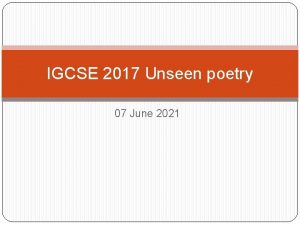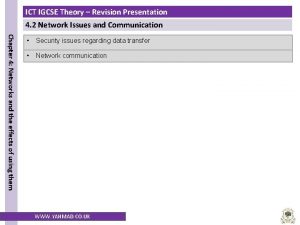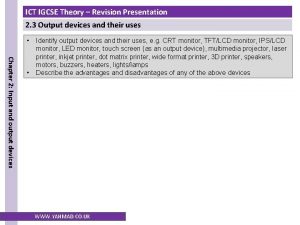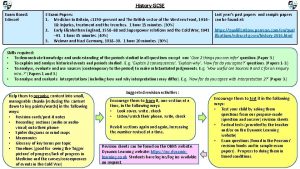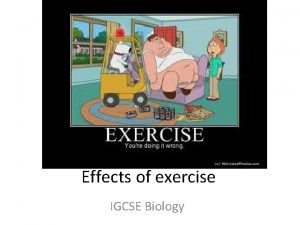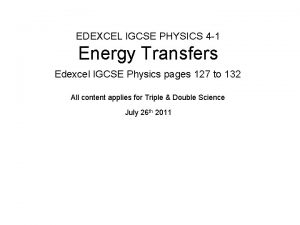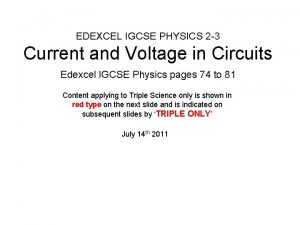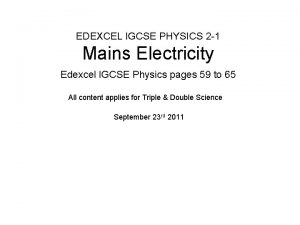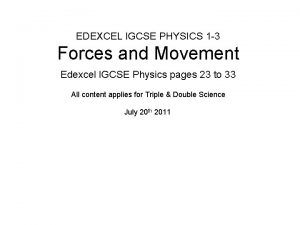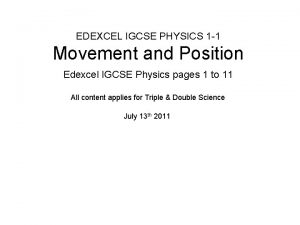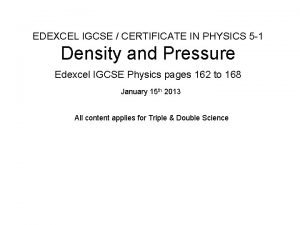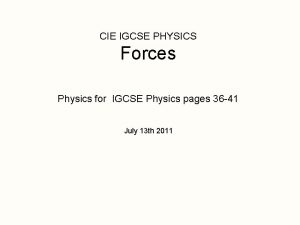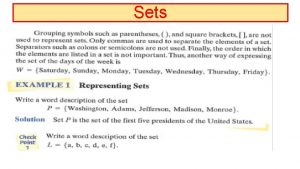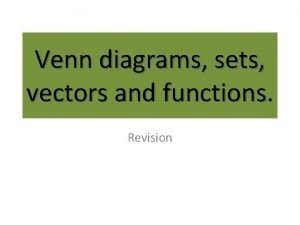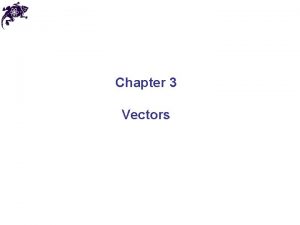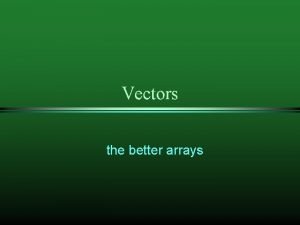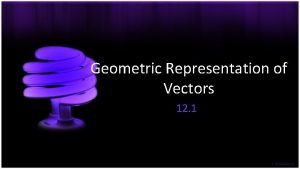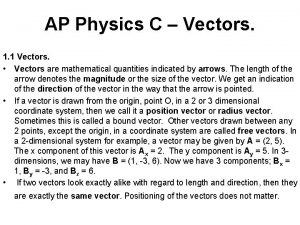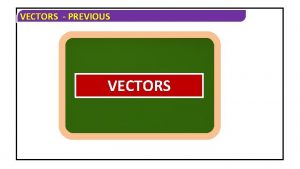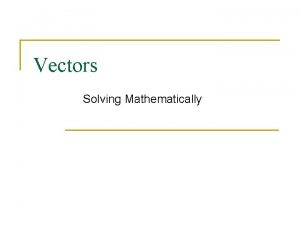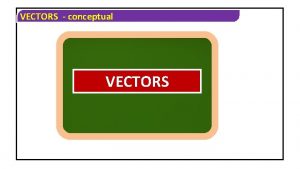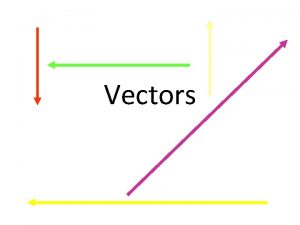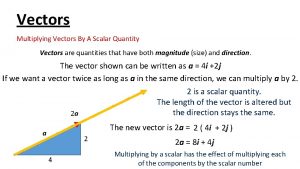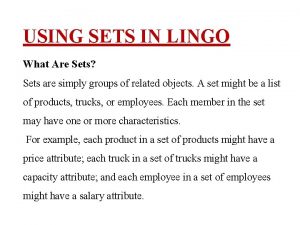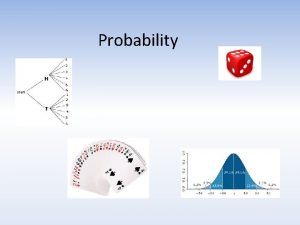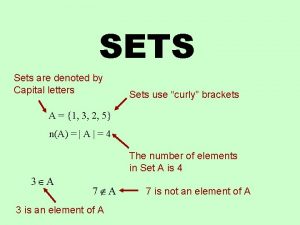Sets Vectors Functions IGCSE Chapter 8 Note 1


































![Note 6: Functions If f : x and g : x √[5(x+2)], find: a. Note 6: Functions If f : x and g : x √[5(x+2)], find: a.](https://slidetodoc.com/presentation_image_h2/565571ced70fe05df139e7fae709e213/image-35.jpg)














- Slides: 49

Sets, Vectors & Functions IGCSE Chapter 8

Note 1: Sets A ∩ B is green A B ∩ - intersection A B - ‘is a subset of’ A A ∩ ∩ U – Union B B

Note 1: Sets X a C - ‘is a member of’ b c ‘belongs to’ bєX a ξ – ‘universal set’ ξ d b e c ξ = {a, b, c, d, e} B ξ A ‘ - ‘complement of’ A U A’ = ξ A

Note 1: Sets n(A) - ’the number of elements in set A’ b A a c n(A) = 3 A = {x : x is an integer, 2 ≤ x ≤ 9} Reads: A is the set of elements x such that x is an integer and 2 ≤ x ≤ 9 The set A is {2, 3, 4, 5, 6, 7, 8, 9}. Ø ∩ Ø or { } - ‘empty set’ A for any set A

Note 1: Sets e. g. In the Venn diagram T R 11 ξ = {students in year 10} R = {Yr 10 students who play Rugby} 15 V = {Yr 10 students who play Volleyball} T = {Yr 10 students who play Tennis} a. ) b. ) c. ) d. ) e. ) How many students play Rugby? 40 How many students do not play Volleyball? 41 How many students play Rugby and Tennis? 14 How many students in total? 90 How many play only 1 of these 3 sports? 31 8 5 9 ξ 13 12 17 V IGCSE Ex 1 Pg 242 -243

Starter If X = {1, 2, 3, . . 10} Y = {1, 3, 5, … 19} Z = {x : x is an integer, 5≤x≤ 11} Find: a. ) X ∩ Y {1, 3, 5, 7, 9} b. ) Y ∩ Z {5, 7, 9, 11} c. ) X ∩ Z {5, 6, 7, 8, 9, 10} d. ) n(X U Y) 15 e. ) n(Z) 7 f. ) X’ U Y’ Ø or { } X 4 2 1 3 13 15 Y ξ 17 5 10 97 11 19 6 8 Z State whether true or false: ∩ ∩ a. ) 7 ε X ∩ Y False b. ) {5, 7, 9, 11} Z c. ) Z X U Y True IGCSE Ex 2 Pg 244

e. g. Draw and shade this diagram to show the following sets: X Y ξ a) X ∩ Y b) (X U Y)’ c) X’ ∩ Y IGCSE Ex 3 Pg 245 -246

e. g. Logical Problems If A = { sheep } B = { sheep dogs } C = { ‘intelligent animals’ } D = { good pet } ∩ Express the following in set language: a) No sheep are ‘intelligent’ animals A ∩ C = Ø b) All sheep dogs make good pets B D c) Some sheep make good pets A ∩ D = Ø ∩ Interpret the following statements: a) B C All sheep dogs are intelligent animals b) B U C = D All sheep dogs and all intelligent animals make good pets c) A ε D Sheep do not make good pets

e. g. Logical Problems Of 27 students in the class, 18 play chess, 15 play piano and 7 do both. How many do neither? 27 students = 11 + 7 + 8 + X 27 – 11 – 7 – 8 = X X=1 There is only 1 student who does not play either piano or chess. C P 11 7 8 1

e. g. Logical Problems The Maths results from the hockey team show that all 16 players passed at least 2 subjects, 8 passed at least 3 subjects and 5 students passed 4 subjects or more. How many passed exactly 2 subjects? 8 What fraction passed exactly 3 subjects? 3/16 3 2 8 ξ 3 5 4 IGCSE Ex 4 Pg 247 -249

Note 2: Vectors A vector is a quantity that has both magnitude and direction. Vectors can be added using scale drawings. Head to Tail Method: a b a a+b b * Notice that this is the same result as b + a Therefore: a+b = b+a

Note 2: Vectors A scalar is a quantity that has magnitude but no direction. e. g. ordinary numbers, & quantities like temperature, mass & volume. We can multiply a vector by a scalar. e. g. x multiplied by 2 gives 2 x x x 2 x e. g. x multiplied by -3 gives -3 x x x * The negative sign reverses the direction of the vector x -3 x x

Note 2: Vectors The result of a – b is the same as a + -b a e. g. Find 3 a – b b a 3 a –b a a -b b e. g. Find -4 a + 2 b b -a -a -a -4 a + 2 b -a

Note 2: Vectors Starting from E each time, find vectors for the following: d c e. g. Find: 2 c EF 3 c + d EC -c + d EA -d EG c – 4 d EL -2 c – 4 d EK K A E D F G H I L C B J M

Note 2: Vectors The result of a – b is the same as a + -b. d e. g. Find: DE DG HJ GB BE GC CG = 2 c = c – 2 d = 2 c + 3 d = -c – d = 4 c + 3 d = -4 c – 3 d A G F H I C B E D J c

Note 2: Vectors Write each vector in terms of a, b and c. e. g. AB DE DC HD FE BE EA DG = -2 a = -a - c = -4 a = 2 a + c =b+a = 2 b = -2 b + 2 a ( c ) = 2 b – 2 a D a A 2 a B a C b c c F b G a E a H

Note 2: Vectors Write each vector in terms of a, b only e. g. D = -3 a + 2 b DE HD = 4 a – 2 b a A 2 a B a C b c c F b G a E a H IGCSE Ex 5 Pg 251 -252

Starter OA = a and OB = b e. g. Using the figure, express each of the following vectors in terms of a and/or b. a) AP b) AB c) OQ d) PO e) PQ f) PN g) ON h) AN i) BP j) QA AP = OA OB = BQ NP = QN = a = -a + b = 2 b = -2 a + 2 b = ½ PQ = -a + b = 2 a + PN = a + b = a + PN = b = -b + 2 a = -2 b + a Q B b O b N A a a P

Note 2: Vectors OA = a and OB = b e. g. Using the figure, express each of the following vectors in terms of a and/or b a. ) AP b. ) AB c. ) OQ d. ) PO e. ) PQ f. ) PN g. ) ON h. ) AN i. ) BP j. ) QA AP = 3 OA OB = 1/2 BQ NP = QN = 3 a = -a + b = 3 b = -4 a + 3 b = ½ PQ = -2 a + 3/2 b = 4 a + PN = 2 a + 3/2 b = 3 a + PN = a + 3/2 b = -b + 4 a = -3 b + a b O b B a Q N b A a a a P

Note 2: Vectors ABCDEF is a regular hexagon with AB representing the vector s and AF representing the vector t. Find the vector representing AC. s BC ==? s + t AC = AB + BC = s + (s + t) = 2 s + t s B t C A t IGCSE Ex 6 Pg 253 -255 D F E

Note 3: Column Vectors The vector AB can be written as a column vector. AB = ( ) 2 3 Horizontal Component (Movement in x direction) Vertical Component (Movement in y direction) F B A C ( ) 0 3 5 -3 E D H G ( ) -2 0

Note 3: Column Vectors We can easily add column vectors. ( )+( ) =( ) 3 2 AB + CD = AB = ( ) 3 2 CD = ( ) 7 -3 10 -1 B C A AB + CD D * A vector is described by its length and direction, NOT its position 7 -3

Note 3: Column Vectors Similarly, subtracting column vectors. ( )−( ) =( ) AB − CD = AB = ( ) 6 1 CD = ( ) 5 -2 6 1 5 -2 1 3 C AB – CD B A * A vector is described by its length and direction, NOT its position D

Note 3: Column Vectors Multiplying by a scalar AB = ( ) 6 1 ( ) =( ) 2 AB = 2 6 1 12 2 B Each component is multiplied by 2 2 AB A * A vector is described by its length and direction, NOT its position

Note 3: Column Vectors are parallel if they have the same direction. i. e. Both components must be in the same ratio. e. g. ( ) is parallel to ( ) 6 1 is parallel to ( ) 12 2 -10 4 5 -2 In general, two vectors are parallel if one is a scalar multiple of the other. k ( ) a b is parallel to ( ). a b IGCSE Ex 7 Pg 257 -258

Note 3: Column Vectors y If A has coordinates (1, 2) and B has coordinates (6, 4), find the column vector for AB. AB = ( ) 5 2 B A Find the column vector for BA. BA = ( ) -5 -2 x

Note 3: Column Vectors y Given the following diagram, determine the coordinates of the point A in order to make ABCD a parallelogram. C D A = (1, 0) B Notice the column vector for AB = DC AD = BC ( ) 4 1 1 3 A x

Note 3: Column Vectors ( ) 5 3 y=-x y y=x Find the image of the vector after reflection in the following lines: a) y = 0 b) x = 0 c) y = x d) y = -x ( ( 5 -3 -5 3 3 5 -5 -3 ) ) x IGCSE Ex 8 Pg 258 -259

Note 4: Modulus of a Vector The modulus of a vector a is written a. This represents the magnitude (or length) of the vector. As shown in the diagram: a= B ( ) 5 3 We can find the length using Pythagoras’ Theorem: |a|= √ (52+32) |a|= √ 34 units 3 A 5

Note 4: Modulus of a Vector e. g. If AB = AB + BC = ( )& 5 3 BC = ) +( ) -4 1 B ( ) (12+42) |AC|= √ 17 units AC. C 1 4 We can find the length using Pythagoras’ Theorem: |AC|= √ ( ) find -4 1, A IGCSE Ex 9 Pg 260 -261

Note 5: Vector Geometry Position vectors give the position of a point relative to the origin, O. In the diagram we see that OD = 2 OA, OE = 4 OB, OA = a and OB = b a. ) Express OD and OE in term of a and b respectively OD = 2 a OE = 4 b C b. ) Express BA in terms of a and b D BA = -b + a c. ) Express ED in terms of a and b A ED = -4 b + 2 a a d. ) Given that BC = 3 BA, express OC in terms of a and b b O OC = OB + BC OC = b + -3 b +3 a OC = -2 b +3 a B E

Note 5: Vector Geometry Position vectors give the position of a point relative to the origin, O. In the diagram we see that OD = 2 OA, OE = 4 OB, OA = a and OB = b e. ) Express EC in terms of a and b EC = EO + OC EC = -4 b + OC From part (d) IGCSE Ex 10 Pg 262 -264 C OC = -2 b +3 a D EC = -4 b – 2 b + 3 a A EC = -6 b + 3 a e. ) Show that E, D and C lie on a straight line From part (c) ED = -4 b + 2 a O a b B EC and ED are parallel vector that pass through the same point, E E

Starter

Note 6: Functions Function Notation f(x) = x 2 + 3 or f: x x 2 +3 We can read this as “the function f, such that, x is mapped on x 2 +3 If f(x) = 7 x – 5 and g(x) = 2 x 2 +5, find: a. ) f(2) b. ) f(-4) c. ) g(3) d. ) g(0) f(2) = 7(2) - 5 f(-4) = 7(-4) - 5 g(3) = 2(3)2 + 5 g(0) = 0 + 5 f(2) = 9 f(-4) = -33 g(2) = 23 g(0) = 5
![Note 6 Functions If f x and g x 5x2 find a Note 6: Functions If f : x and g : x √[5(x+2)], find: a.](https://slidetodoc.com/presentation_image_h2/565571ced70fe05df139e7fae709e213/image-35.jpg)
Note 6: Functions If f : x and g : x √[5(x+2)], find: a. ) x if f(x) = 40 b. ) x if g(x) = 10 5 x 2 = 40 2 √[5(x+2)] = 10 5 x 2 = 2 x 40 5 x 2 = 80 x 2 = 16 x=± 4 [5(x+2)] = 102 5(x+2) = 100 (x+2) = 20 x = 18

Note 6: Functions (flow diagrams) We can illustrate functions using flow diagrams. e. g. x The function (7 x + 8)2 consists of 3 simpler functions multiply by 7 7 x add 8 7 x+8 square (7 x+8)2

Note 6: Functions e. g. The functions h and k are defined as follows: h: x x 2 + 1, k: x ax + b, where a and b are constants. If h(0) = k(0) and k(2) = 15, find values of a and b h(0) = 02 + 1 =1 k(0) = 1 a(0) + b = 1 b =1 k(2) = 15 a(2) + 1 = 15 2 a + 1= 15 2 a = 14 a=7 IGCSE Ex 11 Pg 265 -267

Note 7: Composite Functions Consider f(x) = x 4 and g(x) is 2 x + 3 fg means that g converts x to 2 x + 3, …. . and then…… f converts 2 x + 3 to (2 x + 3)4

Note 7: Composite Functions Consider f(x) = x 4 and g(x) is 2 x + 3 fg means that g converts x to 2 x + 3, …. . and then…… f converts 2 x + 3 to (2 x + 3)4 Notice how this is different from gf gf means that f converts x to x 4 , …. . and then…… g converts x 4 to 2(x 4) + 3 In general, fg = gf You must get used to reading and applying the composite function from right to left

Note 7: Composite Functions Other common notations show fg as f(g(x)) and gf as g(f(x)) e. g. Given f(x) = 2 x + 1 and g(x) = 3 – 4 x, find in simplest form: a. ) fg b. ) gf = f(g(x)) = g(f(x)) = 2(3 – 4 x) + 1 = 3 – 4(2 x + 1) = 6 – 8 x +1 = 3 – 8 x – 4 = 7 – 8 x = – 8 x – 1

Note 7: Composite Functions e. g. Given Find: a. ) fg f: x g: x h: x x 3 4 + 5 x 2 x b. ) gh c. ) fgh = f(g(x)) = g(h(x)) = fg(h(x)) = (4 + 5 x)3 = 4 + 5(2 x) = 4 + 10 x = f(4 + 5(2 x)) d. ) gf(2) = g(f(x)) = 4 + 5 x 3 = 4 + 5(2)3 = 44 d. ) ff(-1) = (x 3)3 = x 9 = (-1)9 = -1 = f(4 + 10 x) = (4 + 10 x)3

Note 7: Composite Functions e. g. Given Find: f: x g: x h: x a. ) x if fg = 0 f(g(x)) = 0 2 x – 8 x+4 7 x 2 b. ) ggg(5) g ((x+4) + 4)) c. ) x if f(x) = g(x) 2 x – 8 = x + 4 2(x + 4) – 8 = 0 = g (x+ 8) x =4+8 2 x + 8 – 8 = 0 = (x+4) + 8 x = 12 2 x = 0 = x + 12 x=0 = 5 + 12 = 17 IGCSE Ex 12 Pg 268 -269 #1 -8

Note 8: Inverse Reversing Functions (undoing) a function The operations: + and – × and ÷ x 2 and √x are all inverse operations because one undoes the other If a function f maps a number n onto m then its inverse function f-1 will map m onto n.

Recall: Column Vectors ( ) 5 3 y y=x Find the image of the vector after reflection in the following lines a. ) y = 0 b. ) x = 0 c. ) y = x d. ) y = -x ( ( 5 -3 -5 3 3 5 -5 -3 ) ) x

Note 8: Inverse Functions We can find the inverse of a function using a flow diagram f(x) = x Multiply by 3 3 x Subtract 5 3 x-5 Divide by 4 Now, start on the right hand side and replace each operation with its inverse Divide by 3 4 x+5 Add 5 Thus, f-1(x) = 4 x Multiply by 4 x

You try! Find the inverse of f(x) = 4 x-2 x (x+2)/4 So *4 /4 f -1 (x)=(x+2)/4 -2 +2 4 x-2 x IGCSE Ex 12 Pg 268 -269 #9 -22

A neat little trick… Ø As always in maths, there is a trick to this… f(x) = 5 x + 7 1. Write function as a rule in terms of y and x. y = 5 x + 7 2. Swap ‘x’ and ‘y’ x = 5 y + 7 x -7 = 5 y 3. Rearrange to make ‘y’ the subject. y = (x-7)/5 f-1(x) =

Reflecting. .

Inverse functions only exist for one-one functions. i. e. functions where each input (x) can only lead to one possible output ( f(x) )
 Difference between note making and note taking
Difference between note making and note taking Signal words examples
Signal words examples Difference between note making and note taking
Difference between note making and note taking Financial documents in order
Financial documents in order What is debit note
What is debit note Debit note là gì
Debit note là gì Note making advantages
Note making advantages Simple interest note vs simple discount note
Simple interest note vs simple discount note Correspondence function examples
Correspondence function examples Igcse history chapter 6
Igcse history chapter 6 Ict igcse theory revision presentation
Ict igcse theory revision presentation Igcse ict networks
Igcse ict networks Ict igcse theory
Ict igcse theory Igcse ict chapter 5 questions
Igcse ict chapter 5 questions Igcse ict
Igcse ict Chapter 2: force vectors solutions
Chapter 2: force vectors solutions Chapter 3 vectors worksheets
Chapter 3 vectors worksheets Chapter 12 vectors and the geometry of space
Chapter 12 vectors and the geometry of space Dot product
Dot product This chapter shows how vectors can be added using
This chapter shows how vectors can be added using Piecewise function absolute value
Piecewise function absolute value How to solve evaluating functions
How to solve evaluating functions Evaluating functions and operations on functions
Evaluating functions and operations on functions Young and dyslexic language and structure
Young and dyslexic language and structure Sphere of influence geography igcse
Sphere of influence geography igcse Night alice munro
Night alice munro Igcse cambridge livelli
Igcse cambridge livelli Igcse teacher training
Igcse teacher training Igcse sociology family notes
Igcse sociology family notes Kinetic energy forms
Kinetic energy forms Edexcel igcse english language young and dyslexic
Edexcel igcse english language young and dyslexic Dr frost graphs
Dr frost graphs Peel exam technique
Peel exam technique English igcse tips
English igcse tips How to measure the size of a business igcse
How to measure the size of a business igcse Igcse poems 2021
Igcse poems 2021 Ict igcse theory revision presentation
Ict igcse theory revision presentation Ict igcse theory
Ict igcse theory Edexcel past papers history
Edexcel past papers history Whats oxygen debt
Whats oxygen debt Energy flow diagrams physics
Energy flow diagrams physics Igcse circuit symbols
Igcse circuit symbols Circuit breaker igcse
Circuit breaker igcse Edexcel igcse physics forces and motion questions
Edexcel igcse physics forces and motion questions Distance time graph for uniform motion
Distance time graph for uniform motion Density and pressure igcse physics
Density and pressure igcse physics Edexcel igcse computer science
Edexcel igcse computer science Edexcel past papers english literature
Edexcel past papers english literature English language igcse paper 1
English language igcse paper 1 Types of forces igcse physics
Types of forces igcse physics








